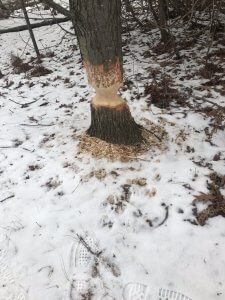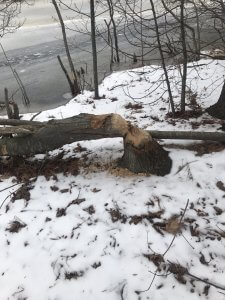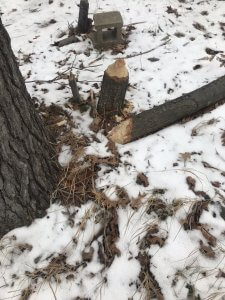Beavers are the largest yet most elusive rodent species in Michigan. Even though these mammals often top the scales at more than 50 lbs, it’s quite challenging to scope them out because of their mostly nocturnal and semi-aquatic tendencies. They are hands down the best dam builders in the state (HAHA). In late autumn, beavers prepare for winter by improving their dams, adding extra sticks and mud to their lodges; but also, and most importantly, beavers stock their underwater pantries. Wildlife biologists like to call the winter food cache a ‘Beaver Freezer.’ Rarely does a human look inside these underwater sites; as ice freezes, it quickly becomes opaque, snow blocks any view.
What are food caches?
Each fall, beavers that live in cold areas (including all of Michigan) construct various Beaver Freezers in relatively deep waters close to their lodge or just a short swim away under the ice. Each Beaver Freezer is an accumulation of tree branches and sustains the family throughout the winter months. As the days of autumn wane, the diligent beavers fell and gnaw tree limbs and saplings into short, manageable lengths, dragging them to the lakeshore. In doing so, they move along canals they’ve created to keep exposure to predators at a minimum. Once back in the lake, the beavers jab one end of a limb into the muddy floor to secure it in place. After few days of this, these winter caches look like miniature underwater forests.
What do beavers eat?
When a beaver becomes hungry, they can flip down into one of the lodge openings beneath the ice and swim to their underwater Beaver Freezer. The beavers then drag the day’s meal into the lodge’s feeding chamber, strip off and eat the bark and inner cambium layers where the nutrients are, and discard the rest. This method is not too far removed from humans eating corn on the cob. This winter, the remains of some early woody meals floated up to the bottom of the clear ice and can be seen next to trapped air bubbles exposing a secret of the beaver freezer.
When spring approaches, or if the ice melts early, the adult beavers emerge from their dark aquatic world to feed on fresh woody stems and emergent vegetation along the shore. During these forays, they are vulnerable to wolves and cougars in the north country of Michigan’s Upper Peninsula. In the Lower Peninsula, they draw the attention of coyotes. But now, as winter settles in, the beavers are safe and secure in their snow-capped lodges.
As mentioned previously, beavers fell and gnaw trees surrounding bodies of water. Oftentimes these trees happen to be on property under the ownership of humans. Humans do not take kindly to flooded property or babbling brooks running dry. In these cases, property owners need to seek professionals’ aid to assist in curbing the beaver problem. Not only is Hogarth’s Pest Control and Wildlife Removal skilled in beaver trapping and removal— we rather enjoy it! Please do not hesitate to reach out to us if you require assistance. We are happy to help!


